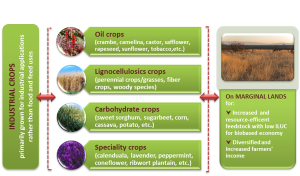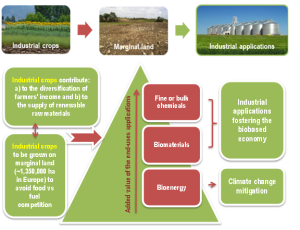Industrial crops can provide abundant renewable biomass feedstocks for the production of high-added-value bio-based commodities (i.e. bio-plastics, bio-lubricants, bio-chemicals, pharmaceuticals, bio-composites, etc.) and bioenergy. They can be broadly categorised as oil, lignocellulosic, carbohydrate or specialty crops. Most of them are multipurpose crops offering the opportunity to follow a cascade bio refinery concept to produce a number of value added bio products and bioenergy, thus feeding the bio based economy. Prospectively, industrial crops can increase and diversify farmers’ income through access to novel bio-based markets (i.e. bulk and fine chemical, biomaterial or bioenergy industries, amongst others), and the possibility to exploit marginal land with limited value for conventional agriculture.
In recent years, a debate has emerged regarding food security and land use for bioenergy/industrial non-food crops. Cultivating industrial crops on marginal land unsuitable for food production is consistently proposed as a viable alternative to minimize land-use competition for food production, and its adverse effects (direct or indirect) on food security, land based GHG emissions and biodiversity loss. The term ‘marginal land’ has entered the wider political debates, and today biofuel crops are generally promoted and supported on marginal land; nonetheless, marginal land has been not yet unequivocally defined, and there is not a clear information on where, when and how much genuine marginal land is available.

Several studies agree on the existence of ~1,350,000 hectares of land in Europe deemed less favourable for conventional agriculture. This land has been either abandoned because of its productivity, or it is used as grassland. MAGIC project (Figure 1) is based on the premise that cultivation of selected industrial crops on areas facing natural constraints (e.g. extreme climatic conditions, low soil productivity, steep slope, etc.) can i) ensure the production of resource-efficient feedstocks, with low indirect land-use change (iLUC), for a growing bio-based industry, and ii) increase farmers’ incomes through access to new markets and the revalorization of marginal land.
It has been estimated that as many as 2.5 million potentially contaminated sites exist across Europe, whose management cost (81% only for remediation) is about € 6.5 billion per year. In MAGIC, contaminated and degraded soils will also be included as it is well documented that the proportion of these land-types is increasing due to anthropogenic activities. Contaminated soils cannot be used for food or feed production for sanitary reasons and thus provide great potential for the production of biomass for material or energy use. In this context, MAGIC project aims towards the development of resource-efficient and economically profitable industrial crops to be grown on marginal land. In the long term, this strategy will foster the sustainable development of the EU bio-based economy and will contribute to achieving EU energy and climate targets.
The concept begind the MAGIC project
A current estimate of marginal land of various types existing in Europe is about 1,350,000 ha, either abandoned because its productivity is too low to provide enough income to farmers, or as underused land by farmers whose income is hardly above their opportunity costs. Agriculture on marginal land with existing (food) crops has few chances to improve as the crops used are not well adapted to marginal conditions. A large number of industrial crops have been tested on both EU and national projects for bio-based products and energy. Most of these crops are reported as crops with ability to grow on marginal land. Thus, the idea to use this land for growing industrial crops as feedstock for the bio-based industry has the advantage that will not affect the food vs fuel competition. Moreover, part of the marginal land has been recorded as contaminated and polluted being inappropriate for food and feed crops growing for sanitary reasons, but can be exploited for industrial crops cultivation.
In 4FCROPS and Crops2Industry projects the industrial crops were categorized to: oil crops, perennial grasses, fibre crops, woody species, carbohydrate crops and other specialty crops. In MAGIC the industrial crops will be categorised in four groups: a) the oil crops (camelina, crambe, lesquerella, cuphea, castor, safflower, flax, etc.), b) the lignocellulosic crops that will include the fibre crops (flax, hemp, kenaf, nettle, biomass sorghum, etc.), the perennial herbaceous crops (switchgrass, giant reed, miscanthus, reed canary grass, etc.) and the woody species (willow, poplar, eucalyptus, robinia, etc.) c) the carbohydrate crops (biomass sorghum, cereals, sugar beet, etc.) and d) specialty crops. Several of the above mentioned crops are multi-purpose ones like hemp, flax and cardoon. It should be pointed out that a large number of specialty crops with pharmaceutical and nutraceuticals uses are oil crops.
There is an increasing need for biomass feedstock for industrial uses in Europe and quite important research has been carried out as early as the beginning of 1990’s for a large number of industrial crops as a feedstock for value added bio-products (biochemicals, biomaterials, etc.) and bioenergy; however, their insertion into European agricultural practice is still limited. A large number of projects for industrial crops have been funded and outstanding innovations have been achieved from production to the end use. On the other hand, the market share for bio-based products in EU28 presents a fast growing trend, as a result of the increased awareness and product availability in the EU markets. Much R&I efforts has been made in recent years to produce biofuels (e.g. 2nd generation bioethanol) from industrial crops. Europe has a few small companies specialised in bio-based products and several major chemical companies developing bio-based applications. At this point, it is worthwhile to mention that in 2010 the European chemical industry used about 8-10% renewable materials to produce various chemical substances and polymers. For the revival of rural areas in regions with marginal lands, new options need to be developed ensuring higher economic margins for farmers, while, at the same time providing products that can compete in the market. Such new options can come from the production of industrial raw materials from crops that have a high resilience to marginal conditions.

This offers at least five advantages:
• Enable Europe to increase domestic production of feedstocks for the growing EU bio-based economy reducing its dependence on imports.
• Improve the livelihoods in marginal areas by placing abandoned marginal land in use again, thus improving farm income.
• Mitigate the competition between the production of bio-based raw materials and food production.
• Creating new business models for value chains, leading to economic growth and job creation.
• Mitigate environmental and ecological risks by soil abandonment such as soil erosion and natural hazards (avalanche, fire and flood risk).
MAGIC builds on the idea of sustainable exploitation of marginal lands for the cultivation of industrial crops, with low ILUC effects, offering both resource-efficient varieties for attractive industrial applications and diversification of farmers’ revenues through access to new markets (Figure 2).
MAGIC consortium
MAGIC consists of proponents, pioneers and key players within the academic and commercial domain of sustainable production-chains for industrial crops (breeding-agronomyharvesting- logistics-conversion and end-uses) on marginal land. MAGIC will capitalise the outstanding experience and knowledge gained by partners in previous and on-going projects on industrial crops and marginal land maximising its/ their impact beyond completion, avoiding duplications. MAGIC will complement those projects by strengthening the knowhow of the MAGIC consortium within the context of industrial crops on marginal land for a growing bioeconomy. Most of the partners are pioneers in the field of industrial crops and have coordinated or participated on the key research projects that had been funded at EU level with a total budget around of 400 million €. The MAGIC consortium (25 partners from 12 European countries) consists of: research organisations/institutes, universities, SMEs, farmers’ cooperatives, farming consultants and major industry players. A multi-actor forum will also be established including EU and international NGOs and policy makers having an advisory role. Ultimately, this “team-up” of key players corresponds to a first attempt at stream-lining efforts from various fields of knowledge to create a framework for the exploitation of marginal land for the production of industrial crops. MAGIC aims to put all the pieces of the puzzle together in the creation of sustainable bio-based production chains on marginal land.
For further information visit MAGIC website.
This article is by Efthymia Alexopoulou, CRES, Greece.
This project has received funding from the European Union’s Horizon 2020 research and innovation programme under grant agreement No 727698.


